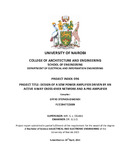Design of a 50w power amplifier driven by an active 4-way cross-over network and a pre-amplifier
Abstract
Most speaker boxes have an electronic circuit inside them called a crossover. Its job is to split the
sound into frequency ranges; it sends the low frequency sounds to the woofer, and the high
frequency sounds to the tweeter. This is important because each
of the loudspeakers is built to
produce certain frequency ranges, and they don
’
t sound very good outside of their proper range.
Most speaker boxes come with passive crossovers built in. The crossovers are made up of some
inductors and capacitors that filt
er the low frequencies from the highs. But passive crossovers have
a number of very significant
drawbacks. The biggest problem with passive crossovers is that they
significantly degrade the quality of the signals that pass through them by introducing disto
rtion.
Music
systems
of today
have separate speakers (woofer, midrange and tweeter) connected to the
output of
amplifiers.
This project entails the design of a 50W power amplifier driven by an active 4
-
way cross
-
over network. An active crossover, is buil
t from the highest quality operational amplifiers
(op
-
amps) and the filter functions are applied to the millivolt level, high impedance, line
-
level
preamp input instead of the low impedance, high voltage level amplifier output.
The
active filters
are to se
parate the sounds into 4
-
band i.e. the Bass
-
band, midrange
-
1, midrange
-
2 and tweeter
-
band.
The biggest advantage of active crossovers is the sound quality. A vanishingly small amount
of noise and distortion is introduced in the op
-
amp filter circuits, on
the order of 0.00005% total
harmonic distortion.
Publisher
University of Nairobi
Description
Project report submitted in partial fulfillment of the requirement for the award of the degree
of
Bachelor of Science in ELECTRICAL AND
ELECTRONIC ENGINEERING
of
the
University of Nairobi 2015

